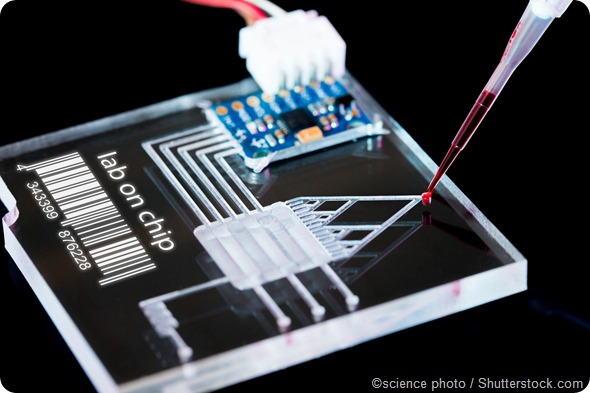Microfluidics is the study of systems that can process small quantities of fluids by using tiny channels having dimensions at the microscale – typically tens to hundreds of micrometres. Although in the nascent stage, microfluidics is rapidly emerging as a breakthrough technology that finds applications in diverse fields ranging from biology and chemistry to information technology and optics.
As more and more researchers realize the power of microfluidics, the technology is being applied to many new fields thus saving money and time spent in research. Despite the compelling advantages of microfluidics, it is not being widely used yet – this is possibly because of the challenges in the commercialization of this technology.
Microfluidics and photolithography
Microfluidic systems are developed using a simple technique called photolithography, which was originally developed for creating small features on circuits in the semiconductor industry. Photolithography is the process used to transfer geometric shapes present on a mask to the surface of a suitable substrate. It makes use of special polymers that react to specific wavelengths of light to create the desired geometric patterns on a substrate.

Polymers such as polydimethylsiloxane (PDMS) have replaced silicon and glass and are widely used in the photolithographic production of microfluidic devices. PDMS is a transparent elastic polymer permeable to oxygen and carbon dioxide and hence is useful for housing cells. Once a mold is created, several tiny devices can be produced using the mold and they can be applied in research and diagnostics.
Advantages of microfluidic systems
- Use of miniscule amounts of samples and reagents in the lab
- Cost reduction due to lesser use of expensive reagents
- High resolution and sensitivity in the detection and separation of molecules
- Reduced footprint of analytical and diagnostic systems compared to huge machines in the lab
- Shorter analysis times and faster results
- Laminar or smooth flow of fluids in tiny channels allows greater flow control
- Greater control of experimental parameters and sample concentration at the micro scale
Applications of microfluidics
- Microfluidic systems are widely used in procedures such as capillary electrophoresis, isoelectric focusing, immunoassays, flow cytometry, sample injection in mass spectrometry, PCR amplification, DNA analysis, separation and manipulation of cells, and cell patterning.
- Research applications of microfluidics are mainly in the study of antibiotic drug-resistant bacteria, nanoparticle transport in blood, and observation of the chemical reaction kinetics.
- Diagnostic uses of microfluidics include cancer and pathogen detection.
- Microfluidic devices are used to measure molecular diffusion coefficients, fluid viscosity, pH, and chemical binding coefficients.
- In the pharmaceutical industry, microfluidic systems have many analytical uses in biopharmaceutical production, e.g., in the monitoring and optimization of protein drugs production and in assays involving human cells.
Marrying Microfluidics and Barcoding Technology/ Cell, May 21, 2015 (Vol. 161, Issue 5)
What’s next in microfluidics?
The development of more sophisticated and innovative technologies for designing and manufacturing microfluidic systems is the need of the hour and can promote commercialization of microfluidic devices.
Dolomite Microfluidics recently launched its innovative 3D fluidics printer called Fluidic Factory, the first commercial 3D printer for fluidically sealed devices such as chips, connectors, valves, fluid manifolds, and medical devices. Similarly, in order to overcome fluid volume manipulation issues in current microfluidic control systems, Fluigent, a microfluidics systems manufacturer, developed the MFCS™ series of microfluidic systems based on its patented FASTAB™ technology, which features pressure driven flow control that enables a pulseless flow and greater responsiveness.
Biocompatible polymers such as PDMS might enable embedding microfluidic devices in vivo for biomedical analysis in the future. Microfluidics has the potential to enable single-cell or single-molecule analysis which might allow fundamental investigations in cell and molecular biology. New microfluidic tools are being developed in research labs for use in proteomics, genomics, and metabolomics.
Although in its infancy, microfluidics offers revolutionary and novel capabilities for the future. Hopefully more active academic research can shed some light on how to exploit the potential of this attractive technology.
References
- https://www.harvard.edu/
- http://inbt.jhu.edu/2015/02/11/what-is-microfluidics/
- http://www.dolomite-microfluidics.com/corporate/news/press-releases
- http://faculty.washington.edu/yagerp/microfluidicstutorial/basicconcepts/basicconcepts.htm
- https://www.fluigent.com/
- http://www.microfluidicfuture.com/blog/microfluidics-a-beginners-guide
Further Reading
Last Updated: Jul 19, 2023